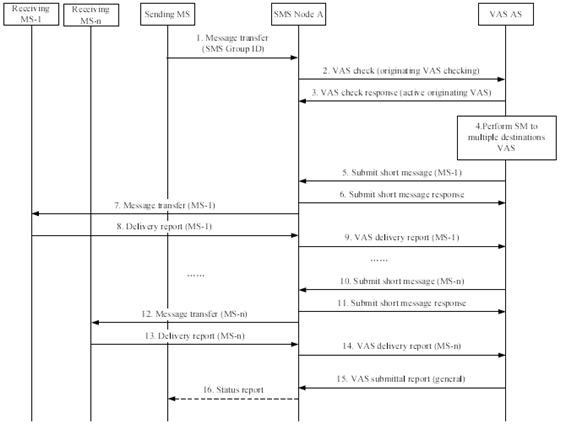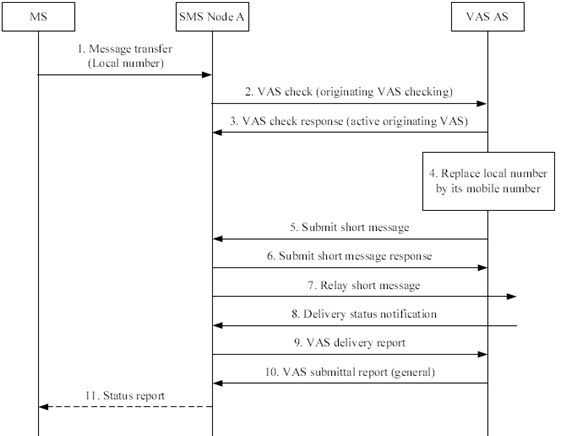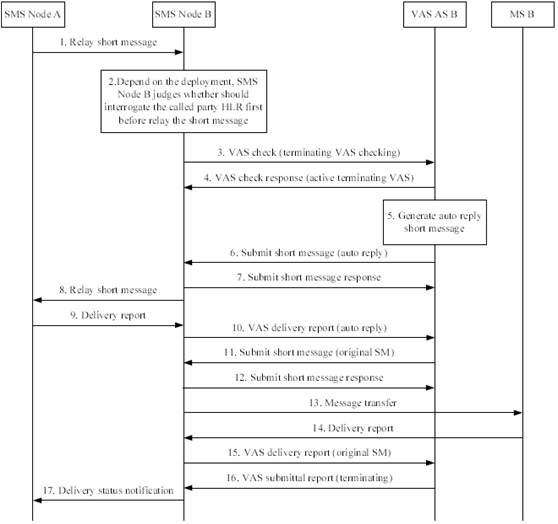Content for TS 23.142 Word version: 18.0.0
7.6 Short Message to multiple destinations
7.7 Short Message Virtual Private Network (VPN)
7.8 Short Message auto reply
7.9 Short Message personal signature
7.10 Short Message deferred delivery
7.6 Short Message to multiple destinations p. 22
In order to support short message to multiple destinations service it is needed for one user to establish a SMS group which is identified by a unique identifier in the VAS AS firstly. The SMS Group ID shall be allocated by VAS AS uniquely and be known by all the members of the SMS group. A SMS group also can be deleted by creator. There may be many ways to manage a SMS group, i.e. create or delete or query a SMS group which is out of the scope of this specification.
When the SMS group is established, every group member can send the short message to all other members in this group by setting the destination to the unique identifier of the SMS group. The procedure of sending message to multiple destinations is described in the following Figure 7.6-1.

Figure 7.6-1: Short Message to multiple destinations service procedure
(⇒ copy of original 3GPP image)
(⇒ copy of original 3GPP image)
Step 1.-3.
These steps are identical to step 1 to 3 of the general message flow described in subclause 7.0. SMS Group ID shall be included in the short message and identified by recipient address.
Step 4.
The VAS AS performs a short message to multiple destinations service and generates new short messages with the same content as the original short message.
Step 5.-14.
The VAS AS separately submits the short message to the SMS Node A with different destination address. These destinations should be all other recipients within the SMS group. There is no sequence requirement of sending short message for VAS AS, i.e. the VAS AS can send the short message in parallel. The SMS Node A receives a delivery report from each receiving MS and relays it to the VAS AS. The VAS AS generates a general delivery report based on the results of the delivery reports from each recipient.
Step 15.-16.
The general delivery report is sent from VAS AS to SMS Node A and transferred to the sending MS by SMS Node if possible.
7.7 Short Message Virtual Private Network (VPN) p. 23
The originating user and the terminating user are in the same VPN and support sending messages to local numbers in the VPN. The local number may be a short number which is bound to mobile number. The mapping table with local number to mobile number shall be stored in the VAS AS. The VAS AS receiving a checking message from SMS Node checks that the originating user activating VPN service, then replace local number by terminating user's mobile number.

Step 1.
The SMS Node A receives a short message to local number from MS and need ask the VAS AS to check whether the originating user has activated VAS.
Step 2.-3.
The VAS AS checks that the originating user has activated VPN service and the destination is a local number. The VAS AS indicates the SMS Node there is active originating VAS for originating user.
Step 4.
The VAS AS replaces the local number by its mobile number and continues according to the general procedure described in clause 7.0 step 4 and following.
7.8 Short Message auto reply p. 23
Short Message Auto Reply is a terminating VAS. The procedure of the short message auto reply refers to the general flow for VAS SMS described in the previous subclause 7.0. The VAS AS checks that the terminating user has activated the Short Message Auto Reply service and generates an auto reply short message which contents have been defined in advance, then deliver it to the originating user.

Step 1.-4.
See general flow described in the previous clause 7.0. The VAS AS checks that a terminating user has activated short message auto reply service and indicates to the SMS Node B there is terminating VAS active.
Step 5.
The VAS-AS B checks a loop prevention indication within the message. If the loop prevention indication is not set, then the VAS AS B generates an auto reply short message and set the loop prevention indication within the auto reply short message to indicate a spawned message. Otherwise an auto reply short message shall not be generated. The VAS AS B stores the original short message for next delivery.
Step 6.-7.
The VAS AS B delivers a short message which is indicated as an auto reply message to the SMS Node B.
Step 8.-9.
The auto reply short message is delivered to the originating user. See TS 23.040 for details.
Step 10.
The VAS AS B receives a delivery report for auto reply message delivery.
Step 11.-17.
The VAS AS B continues to deliver the original short message to the terminating user. See general flow described in the previous clause 7.0.
7.9 Short Message personal signature p. 25
Short Message Personal Signature service is applicable for the originating user. In this case, the VAS AS checks that the originating user has activated the Short Message Personal Signature service and shall append the user's personal signature to the short message. The Short Message Personal Signature procedure refers to the general procedure for VAS SMS which described in the previous clause 7.0.
Short message personal signature should be appended in the last concatenated message for a large message need to be separated into concatenated messages.
7.10 Short Message deferred delivery p. 25
Short Message Deferred Delivery service allows the user to set the short message delivery time. In this case the VAS AS checks that the originating user has activated the short message deferred delivery service. The VAS AS shall store the short message and set the timer to deferred delivery time. The short message should be sent when the timer times out. The deferred delivery time should be determined by the originating user. The service procedure refers to the general flow for VAS SMS which described in the previous clause 7.0.